HLTAAP003: Analyse Client Health Information Assignment
VerifiedAdded on 2022/10/19
|22
|4182
|209
Homework Assignment
AI Summary
This assignment presents a comprehensive analysis of patient health information, encompassing multiple case studies and a series of short-answer questions. The cases explore conditions such as heart failure, diabetes mellitus, COPD, burns, and drug overdose, requiring students to assess vital signs, interpret medical histories, and outline appropriate nursing interventions. Questions delve into the pathophysiology of diseases, the effects of medications like diuretics, and the impact of aging on physiological systems. The assignment emphasizes the importance of understanding electrolyte imbalances, acid-base balance, and the clinical effects of various medical scenarios, including concussion and frostbite. Students are tasked with identifying signs and symptoms, providing rationales for nursing actions, and demonstrating knowledge of relevant diagnostic tests and treatments, thereby showcasing their understanding of patient care and health assessment within a nursing context.
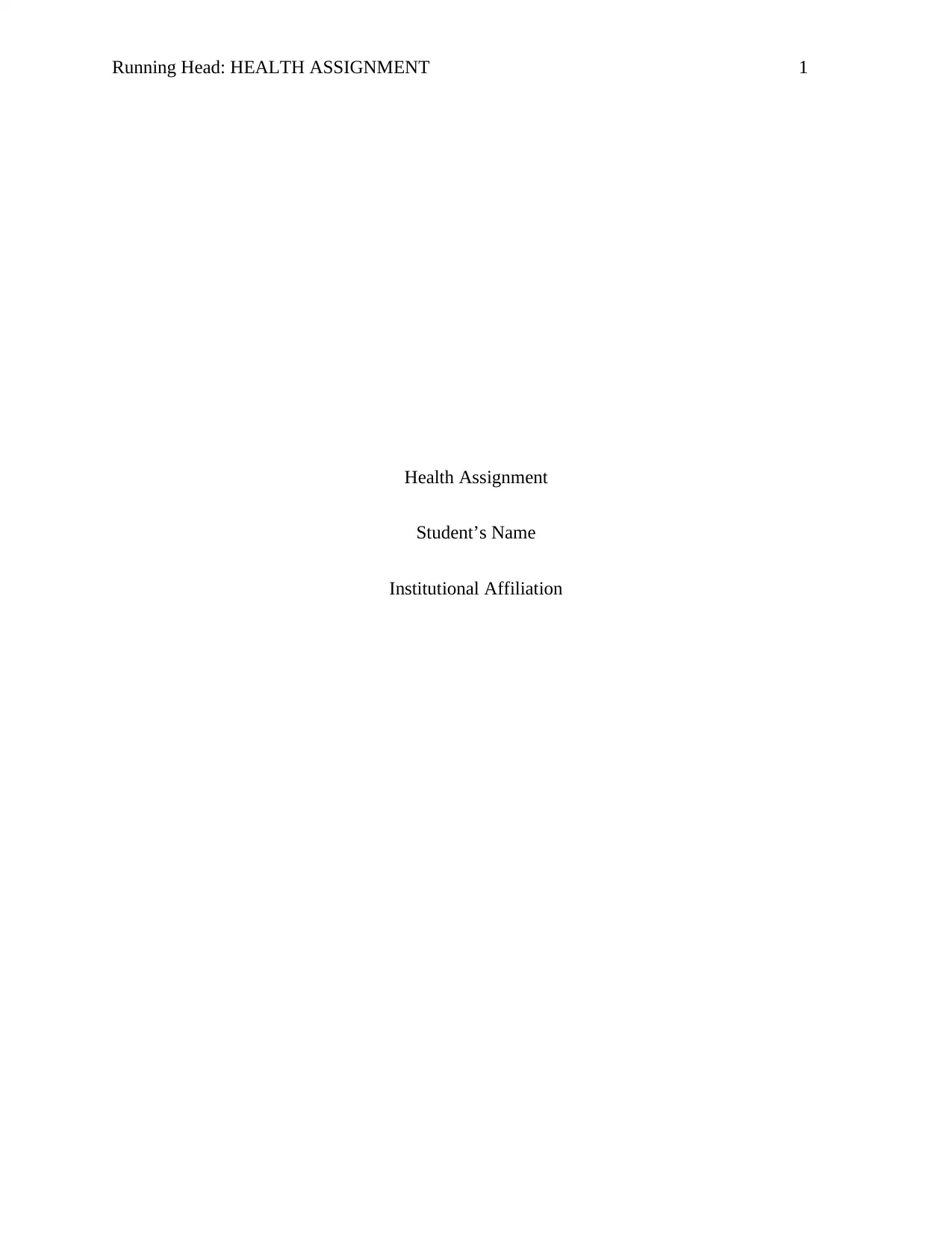
Running Head: HEALTH ASSIGNMENT 1
Health Assignment
Student’s Name
Institutional Affiliation
Health Assignment
Student’s Name
Institutional Affiliation
Paraphrase This Document
Need a fresh take? Get an instant paraphrase of this document with our AI Paraphraser
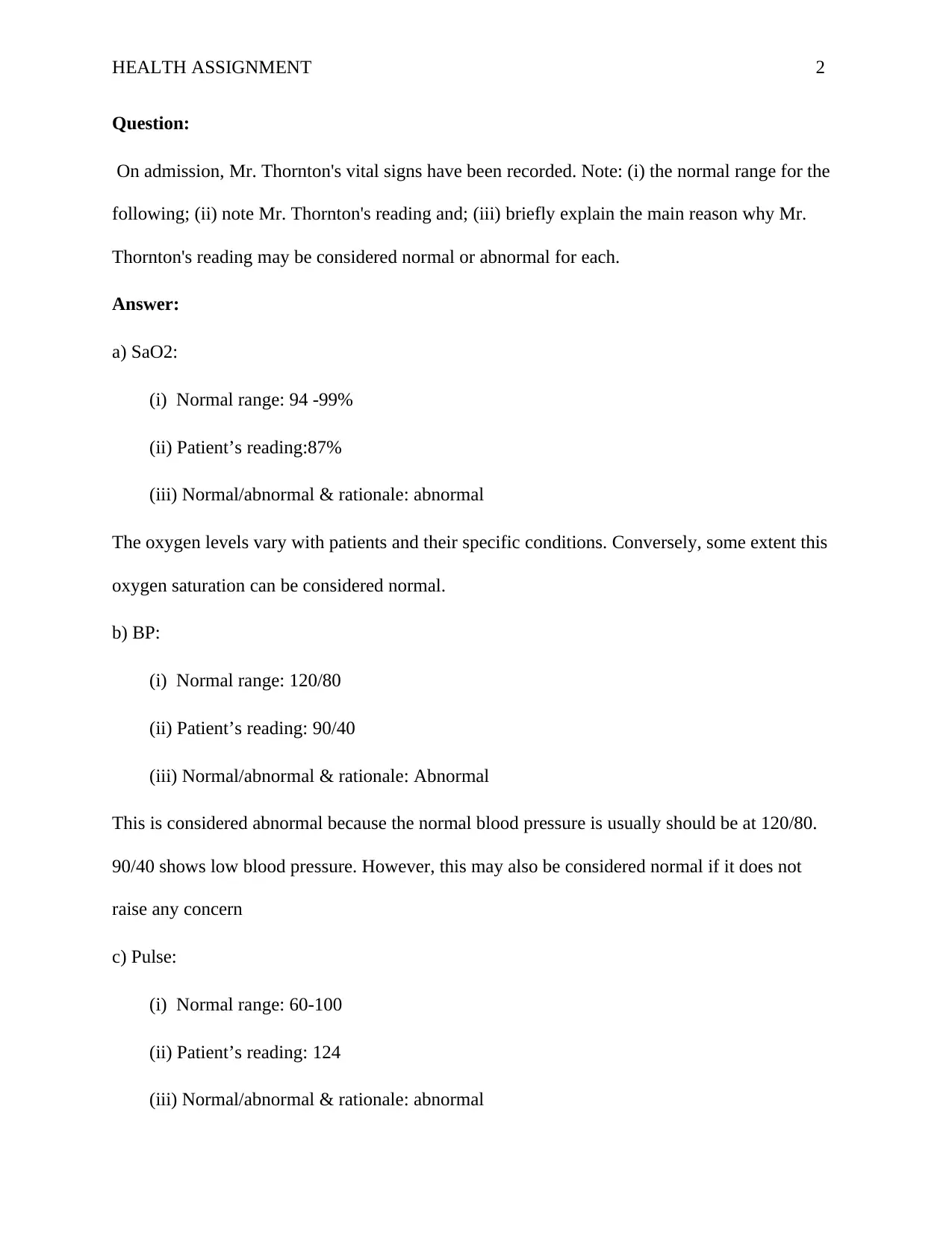
HEALTH ASSIGNMENT 2
Question:
On admission, Mr. Thornton's vital signs have been recorded. Note: (i) the normal range for the
following; (ii) note Mr. Thornton's reading and; (iii) briefly explain the main reason why Mr.
Thornton's reading may be considered normal or abnormal for each.
Answer:
a) SaO2:
(i) Normal range: 94 -99%
(ii) Patient’s reading:87%
(iii) Normal/abnormal & rationale: abnormal
The oxygen levels vary with patients and their specific conditions. Conversely, some extent this
oxygen saturation can be considered normal.
b) BP:
(i) Normal range: 120/80
(ii) Patient’s reading: 90/40
(iii) Normal/abnormal & rationale: Abnormal
This is considered abnormal because the normal blood pressure is usually should be at 120/80.
90/40 shows low blood pressure. However, this may also be considered normal if it does not
raise any concern
c) Pulse:
(i) Normal range: 60-100
(ii) Patient’s reading: 124
(iii) Normal/abnormal & rationale: abnormal
Question:
On admission, Mr. Thornton's vital signs have been recorded. Note: (i) the normal range for the
following; (ii) note Mr. Thornton's reading and; (iii) briefly explain the main reason why Mr.
Thornton's reading may be considered normal or abnormal for each.
Answer:
a) SaO2:
(i) Normal range: 94 -99%
(ii) Patient’s reading:87%
(iii) Normal/abnormal & rationale: abnormal
The oxygen levels vary with patients and their specific conditions. Conversely, some extent this
oxygen saturation can be considered normal.
b) BP:
(i) Normal range: 120/80
(ii) Patient’s reading: 90/40
(iii) Normal/abnormal & rationale: Abnormal
This is considered abnormal because the normal blood pressure is usually should be at 120/80.
90/40 shows low blood pressure. However, this may also be considered normal if it does not
raise any concern
c) Pulse:
(i) Normal range: 60-100
(ii) Patient’s reading: 124
(iii) Normal/abnormal & rationale: abnormal
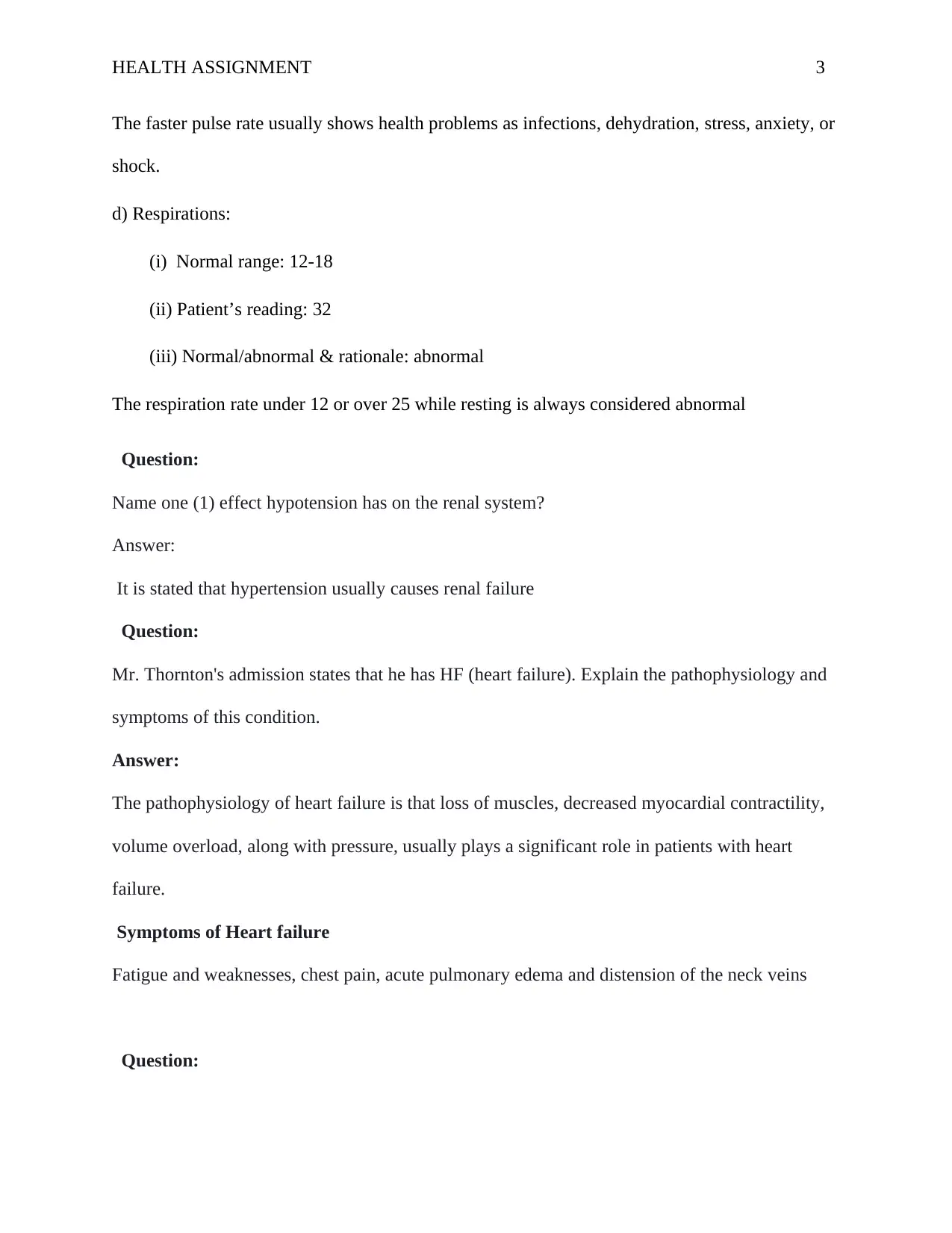
HEALTH ASSIGNMENT 3
The faster pulse rate usually shows health problems as infections, dehydration, stress, anxiety, or
shock.
d) Respirations:
(i) Normal range: 12-18
(ii) Patient’s reading: 32
(iii) Normal/abnormal & rationale: abnormal
The respiration rate under 12 or over 25 while resting is always considered abnormal
Question:
Name one (1) effect hypotension has on the renal system?
Answer:
It is stated that hypertension usually causes renal failure
Question:
Mr. Thornton's admission states that he has HF (heart failure). Explain the pathophysiology and
symptoms of this condition.
Answer:
The pathophysiology of heart failure is that loss of muscles, decreased myocardial contractility,
volume overload, along with pressure, usually plays a significant role in patients with heart
failure.
Symptoms of Heart failure
Fatigue and weaknesses, chest pain, acute pulmonary edema and distension of the neck veins
Question:
The faster pulse rate usually shows health problems as infections, dehydration, stress, anxiety, or
shock.
d) Respirations:
(i) Normal range: 12-18
(ii) Patient’s reading: 32
(iii) Normal/abnormal & rationale: abnormal
The respiration rate under 12 or over 25 while resting is always considered abnormal
Question:
Name one (1) effect hypotension has on the renal system?
Answer:
It is stated that hypertension usually causes renal failure
Question:
Mr. Thornton's admission states that he has HF (heart failure). Explain the pathophysiology and
symptoms of this condition.
Answer:
The pathophysiology of heart failure is that loss of muscles, decreased myocardial contractility,
volume overload, along with pressure, usually plays a significant role in patients with heart
failure.
Symptoms of Heart failure
Fatigue and weaknesses, chest pain, acute pulmonary edema and distension of the neck veins
Question:
⊘ This is a preview!⊘
Do you want full access?
Subscribe today to unlock all pages.

Trusted by 1+ million students worldwide
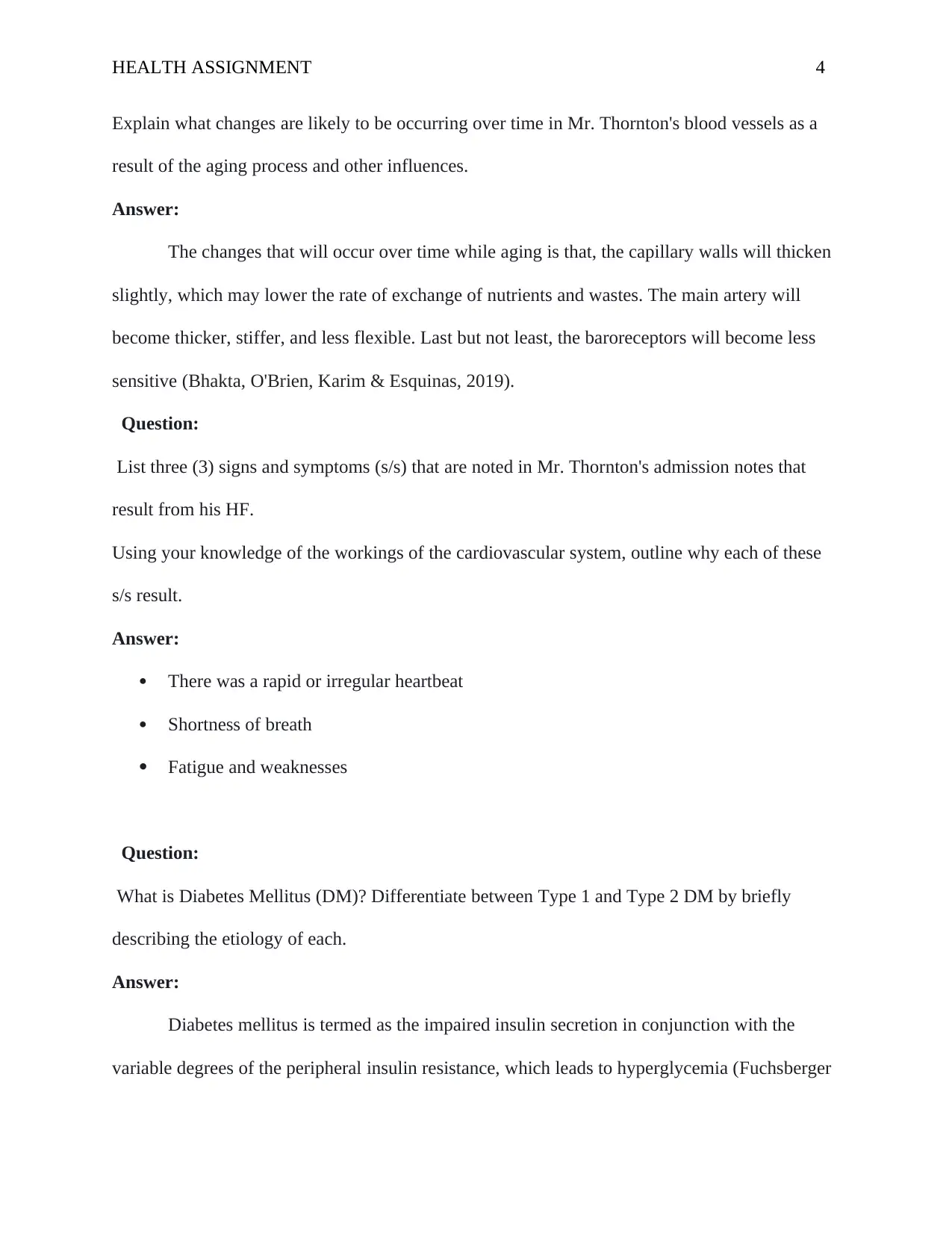
HEALTH ASSIGNMENT 4
Explain what changes are likely to be occurring over time in Mr. Thornton's blood vessels as a
result of the aging process and other influences.
Answer:
The changes that will occur over time while aging is that, the capillary walls will thicken
slightly, which may lower the rate of exchange of nutrients and wastes. The main artery will
become thicker, stiffer, and less flexible. Last but not least, the baroreceptors will become less
sensitive (Bhakta, O'Brien, Karim & Esquinas, 2019).
Question:
List three (3) signs and symptoms (s/s) that are noted in Mr. Thornton's admission notes that
result from his HF.
Using your knowledge of the workings of the cardiovascular system, outline why each of these
s/s result.
Answer:
There was a rapid or irregular heartbeat
Shortness of breath
Fatigue and weaknesses
Question:
What is Diabetes Mellitus (DM)? Differentiate between Type 1 and Type 2 DM by briefly
describing the etiology of each.
Answer:
Diabetes mellitus is termed as the impaired insulin secretion in conjunction with the
variable degrees of the peripheral insulin resistance, which leads to hyperglycemia (Fuchsberger
Explain what changes are likely to be occurring over time in Mr. Thornton's blood vessels as a
result of the aging process and other influences.
Answer:
The changes that will occur over time while aging is that, the capillary walls will thicken
slightly, which may lower the rate of exchange of nutrients and wastes. The main artery will
become thicker, stiffer, and less flexible. Last but not least, the baroreceptors will become less
sensitive (Bhakta, O'Brien, Karim & Esquinas, 2019).
Question:
List three (3) signs and symptoms (s/s) that are noted in Mr. Thornton's admission notes that
result from his HF.
Using your knowledge of the workings of the cardiovascular system, outline why each of these
s/s result.
Answer:
There was a rapid or irregular heartbeat
Shortness of breath
Fatigue and weaknesses
Question:
What is Diabetes Mellitus (DM)? Differentiate between Type 1 and Type 2 DM by briefly
describing the etiology of each.
Answer:
Diabetes mellitus is termed as the impaired insulin secretion in conjunction with the
variable degrees of the peripheral insulin resistance, which leads to hyperglycemia (Fuchsberger
Paraphrase This Document
Need a fresh take? Get an instant paraphrase of this document with our AI Paraphraser
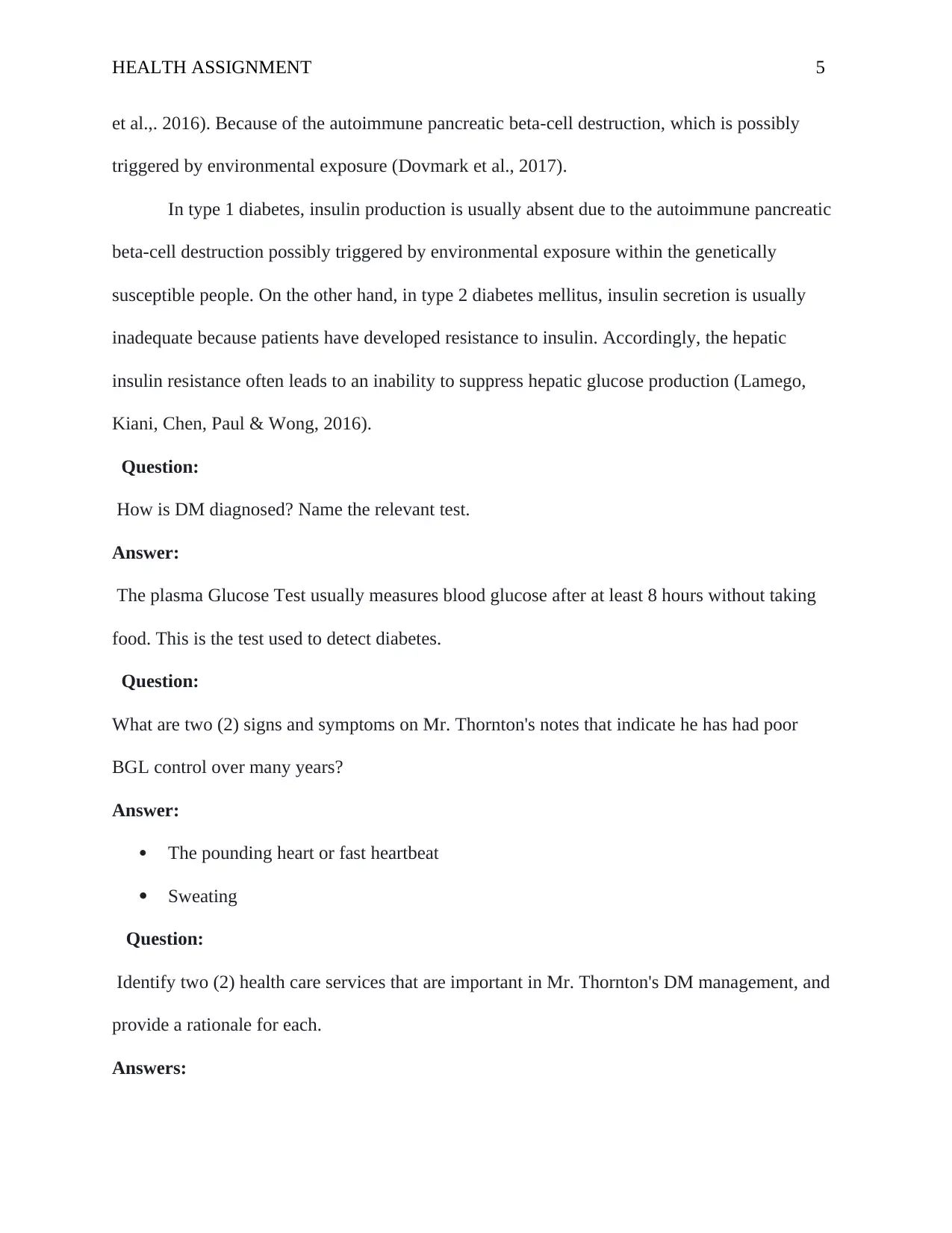
HEALTH ASSIGNMENT 5
et al.,. 2016). Because of the autoimmune pancreatic beta-cell destruction, which is possibly
triggered by environmental exposure (Dovmark et al., 2017).
In type 1 diabetes, insulin production is usually absent due to the autoimmune pancreatic
beta-cell destruction possibly triggered by environmental exposure within the genetically
susceptible people. On the other hand, in type 2 diabetes mellitus, insulin secretion is usually
inadequate because patients have developed resistance to insulin. Accordingly, the hepatic
insulin resistance often leads to an inability to suppress hepatic glucose production (Lamego,
Kiani, Chen, Paul & Wong, 2016).
Question:
How is DM diagnosed? Name the relevant test.
Answer:
The plasma Glucose Test usually measures blood glucose after at least 8 hours without taking
food. This is the test used to detect diabetes.
Question:
What are two (2) signs and symptoms on Mr. Thornton's notes that indicate he has had poor
BGL control over many years?
Answer:
The pounding heart or fast heartbeat
Sweating
Question:
Identify two (2) health care services that are important in Mr. Thornton's DM management, and
provide a rationale for each.
Answers:
et al.,. 2016). Because of the autoimmune pancreatic beta-cell destruction, which is possibly
triggered by environmental exposure (Dovmark et al., 2017).
In type 1 diabetes, insulin production is usually absent due to the autoimmune pancreatic
beta-cell destruction possibly triggered by environmental exposure within the genetically
susceptible people. On the other hand, in type 2 diabetes mellitus, insulin secretion is usually
inadequate because patients have developed resistance to insulin. Accordingly, the hepatic
insulin resistance often leads to an inability to suppress hepatic glucose production (Lamego,
Kiani, Chen, Paul & Wong, 2016).
Question:
How is DM diagnosed? Name the relevant test.
Answer:
The plasma Glucose Test usually measures blood glucose after at least 8 hours without taking
food. This is the test used to detect diabetes.
Question:
What are two (2) signs and symptoms on Mr. Thornton's notes that indicate he has had poor
BGL control over many years?
Answer:
The pounding heart or fast heartbeat
Sweating
Question:
Identify two (2) health care services that are important in Mr. Thornton's DM management, and
provide a rationale for each.
Answers:
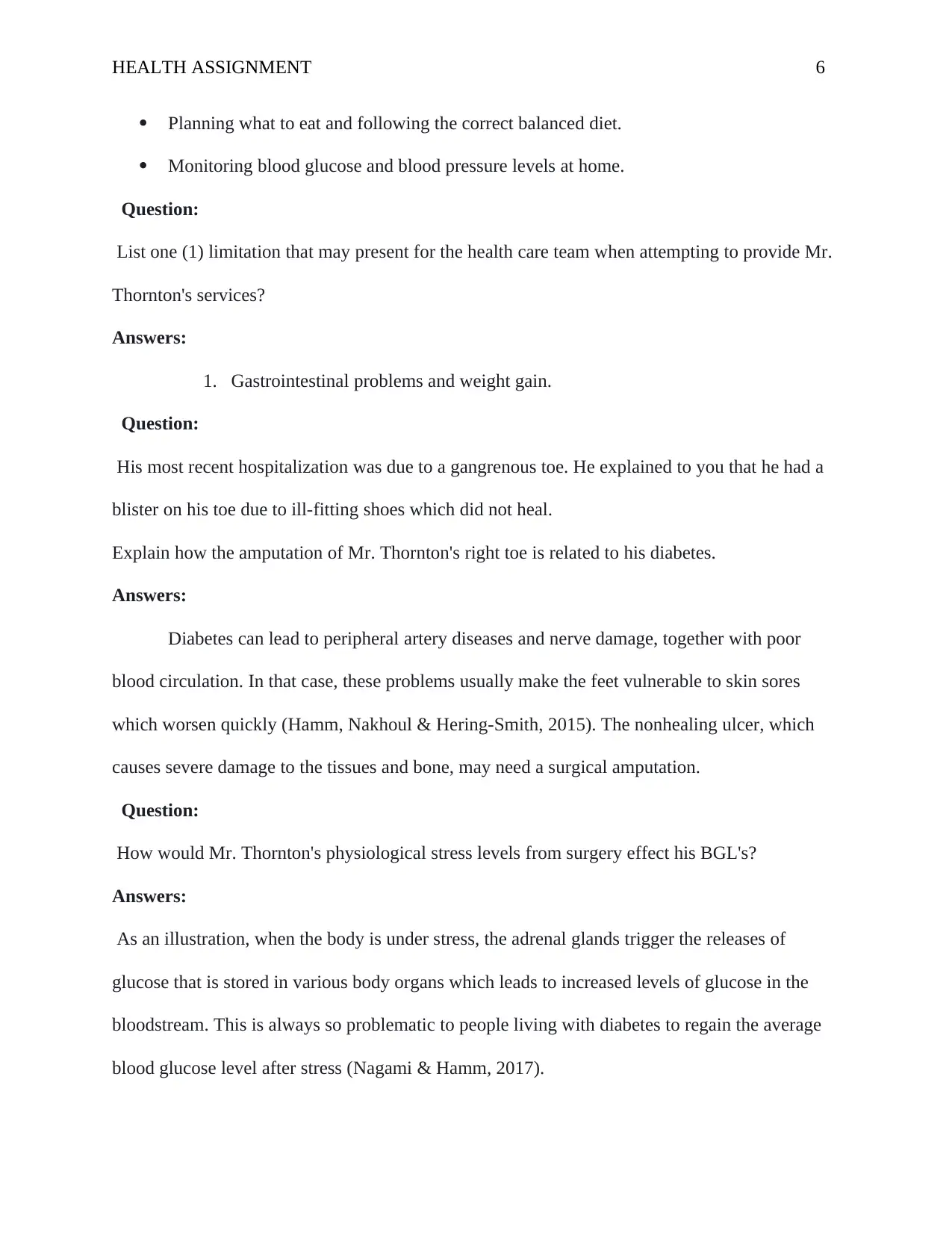
HEALTH ASSIGNMENT 6
Planning what to eat and following the correct balanced diet.
Monitoring blood glucose and blood pressure levels at home.
Question:
List one (1) limitation that may present for the health care team when attempting to provide Mr.
Thornton's services?
Answers:
1. Gastrointestinal problems and weight gain.
Question:
His most recent hospitalization was due to a gangrenous toe. He explained to you that he had a
blister on his toe due to ill-fitting shoes which did not heal.
Explain how the amputation of Mr. Thornton's right toe is related to his diabetes.
Answers:
Diabetes can lead to peripheral artery diseases and nerve damage, together with poor
blood circulation. In that case, these problems usually make the feet vulnerable to skin sores
which worsen quickly (Hamm, Nakhoul & Hering-Smith, 2015). The nonhealing ulcer, which
causes severe damage to the tissues and bone, may need a surgical amputation.
Question:
How would Mr. Thornton's physiological stress levels from surgery effect his BGL's?
Answers:
As an illustration, when the body is under stress, the adrenal glands trigger the releases of
glucose that is stored in various body organs which leads to increased levels of glucose in the
bloodstream. This is always so problematic to people living with diabetes to regain the average
blood glucose level after stress (Nagami & Hamm, 2017).
Planning what to eat and following the correct balanced diet.
Monitoring blood glucose and blood pressure levels at home.
Question:
List one (1) limitation that may present for the health care team when attempting to provide Mr.
Thornton's services?
Answers:
1. Gastrointestinal problems and weight gain.
Question:
His most recent hospitalization was due to a gangrenous toe. He explained to you that he had a
blister on his toe due to ill-fitting shoes which did not heal.
Explain how the amputation of Mr. Thornton's right toe is related to his diabetes.
Answers:
Diabetes can lead to peripheral artery diseases and nerve damage, together with poor
blood circulation. In that case, these problems usually make the feet vulnerable to skin sores
which worsen quickly (Hamm, Nakhoul & Hering-Smith, 2015). The nonhealing ulcer, which
causes severe damage to the tissues and bone, may need a surgical amputation.
Question:
How would Mr. Thornton's physiological stress levels from surgery effect his BGL's?
Answers:
As an illustration, when the body is under stress, the adrenal glands trigger the releases of
glucose that is stored in various body organs which leads to increased levels of glucose in the
bloodstream. This is always so problematic to people living with diabetes to regain the average
blood glucose level after stress (Nagami & Hamm, 2017).
⊘ This is a preview!⊘
Do you want full access?
Subscribe today to unlock all pages.

Trusted by 1+ million students worldwide
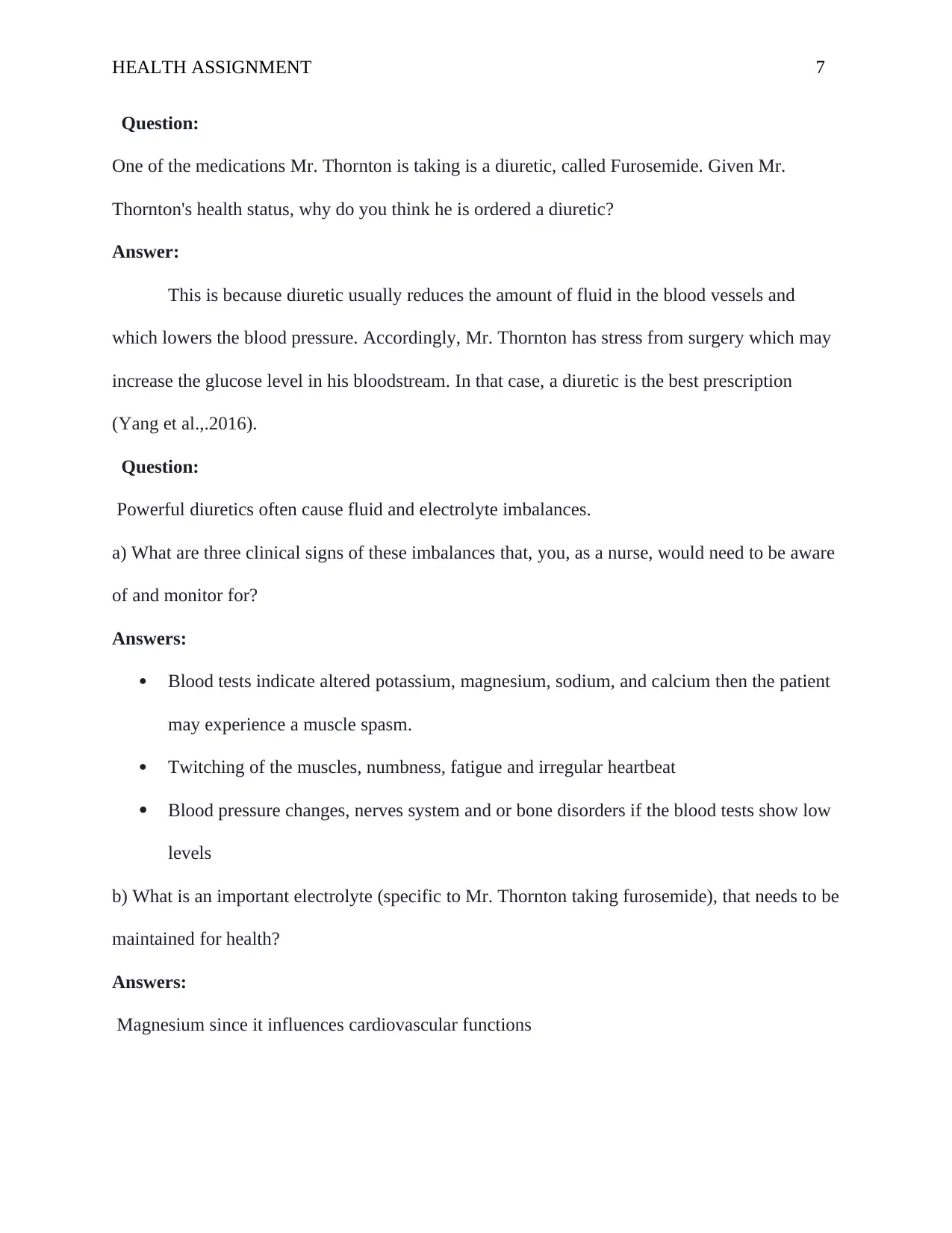
HEALTH ASSIGNMENT 7
Question:
One of the medications Mr. Thornton is taking is a diuretic, called Furosemide. Given Mr.
Thornton's health status, why do you think he is ordered a diuretic?
Answer:
This is because diuretic usually reduces the amount of fluid in the blood vessels and
which lowers the blood pressure. Accordingly, Mr. Thornton has stress from surgery which may
increase the glucose level in his bloodstream. In that case, a diuretic is the best prescription
(Yang et al.,.2016).
Question:
Powerful diuretics often cause fluid and electrolyte imbalances.
a) What are three clinical signs of these imbalances that, you, as a nurse, would need to be aware
of and monitor for?
Answers:
Blood tests indicate altered potassium, magnesium, sodium, and calcium then the patient
may experience a muscle spasm.
Twitching of the muscles, numbness, fatigue and irregular heartbeat
Blood pressure changes, nerves system and or bone disorders if the blood tests show low
levels
b) What is an important electrolyte (specific to Mr. Thornton taking furosemide), that needs to be
maintained for health?
Answers:
Magnesium since it influences cardiovascular functions
Question:
One of the medications Mr. Thornton is taking is a diuretic, called Furosemide. Given Mr.
Thornton's health status, why do you think he is ordered a diuretic?
Answer:
This is because diuretic usually reduces the amount of fluid in the blood vessels and
which lowers the blood pressure. Accordingly, Mr. Thornton has stress from surgery which may
increase the glucose level in his bloodstream. In that case, a diuretic is the best prescription
(Yang et al.,.2016).
Question:
Powerful diuretics often cause fluid and electrolyte imbalances.
a) What are three clinical signs of these imbalances that, you, as a nurse, would need to be aware
of and monitor for?
Answers:
Blood tests indicate altered potassium, magnesium, sodium, and calcium then the patient
may experience a muscle spasm.
Twitching of the muscles, numbness, fatigue and irregular heartbeat
Blood pressure changes, nerves system and or bone disorders if the blood tests show low
levels
b) What is an important electrolyte (specific to Mr. Thornton taking furosemide), that needs to be
maintained for health?
Answers:
Magnesium since it influences cardiovascular functions
Paraphrase This Document
Need a fresh take? Get an instant paraphrase of this document with our AI Paraphraser
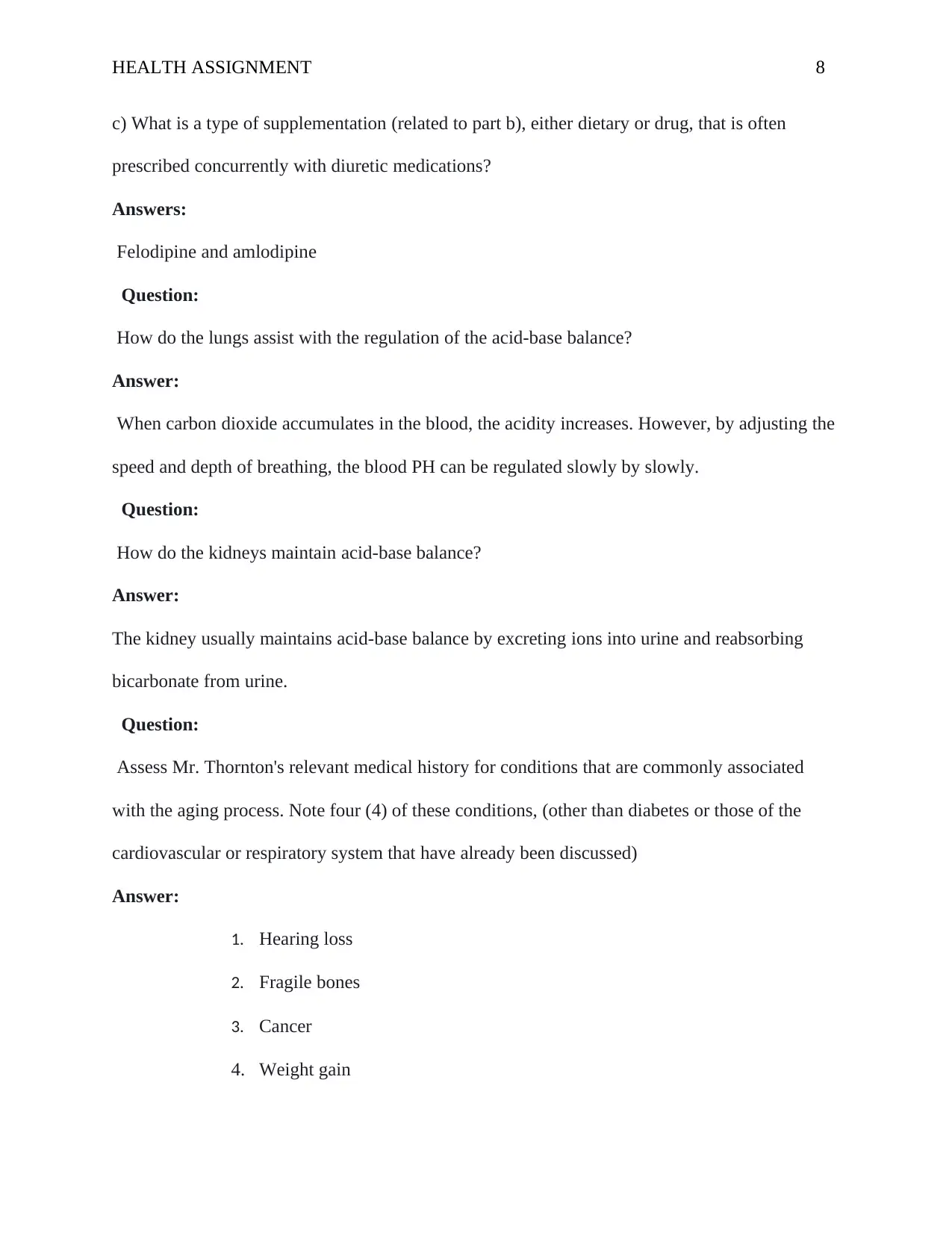
HEALTH ASSIGNMENT 8
c) What is a type of supplementation (related to part b), either dietary or drug, that is often
prescribed concurrently with diuretic medications?
Answers:
Felodipine and amlodipine
Question:
How do the lungs assist with the regulation of the acid-base balance?
Answer:
When carbon dioxide accumulates in the blood, the acidity increases. However, by adjusting the
speed and depth of breathing, the blood PH can be regulated slowly by slowly.
Question:
How do the kidneys maintain acid-base balance?
Answer:
The kidney usually maintains acid-base balance by excreting ions into urine and reabsorbing
bicarbonate from urine.
Question:
Assess Mr. Thornton's relevant medical history for conditions that are commonly associated
with the aging process. Note four (4) of these conditions, (other than diabetes or those of the
cardiovascular or respiratory system that have already been discussed)
Answer:
1. Hearing loss
2. Fragile bones
3. Cancer
4. Weight gain
c) What is a type of supplementation (related to part b), either dietary or drug, that is often
prescribed concurrently with diuretic medications?
Answers:
Felodipine and amlodipine
Question:
How do the lungs assist with the regulation of the acid-base balance?
Answer:
When carbon dioxide accumulates in the blood, the acidity increases. However, by adjusting the
speed and depth of breathing, the blood PH can be regulated slowly by slowly.
Question:
How do the kidneys maintain acid-base balance?
Answer:
The kidney usually maintains acid-base balance by excreting ions into urine and reabsorbing
bicarbonate from urine.
Question:
Assess Mr. Thornton's relevant medical history for conditions that are commonly associated
with the aging process. Note four (4) of these conditions, (other than diabetes or those of the
cardiovascular or respiratory system that have already been discussed)
Answer:
1. Hearing loss
2. Fragile bones
3. Cancer
4. Weight gain
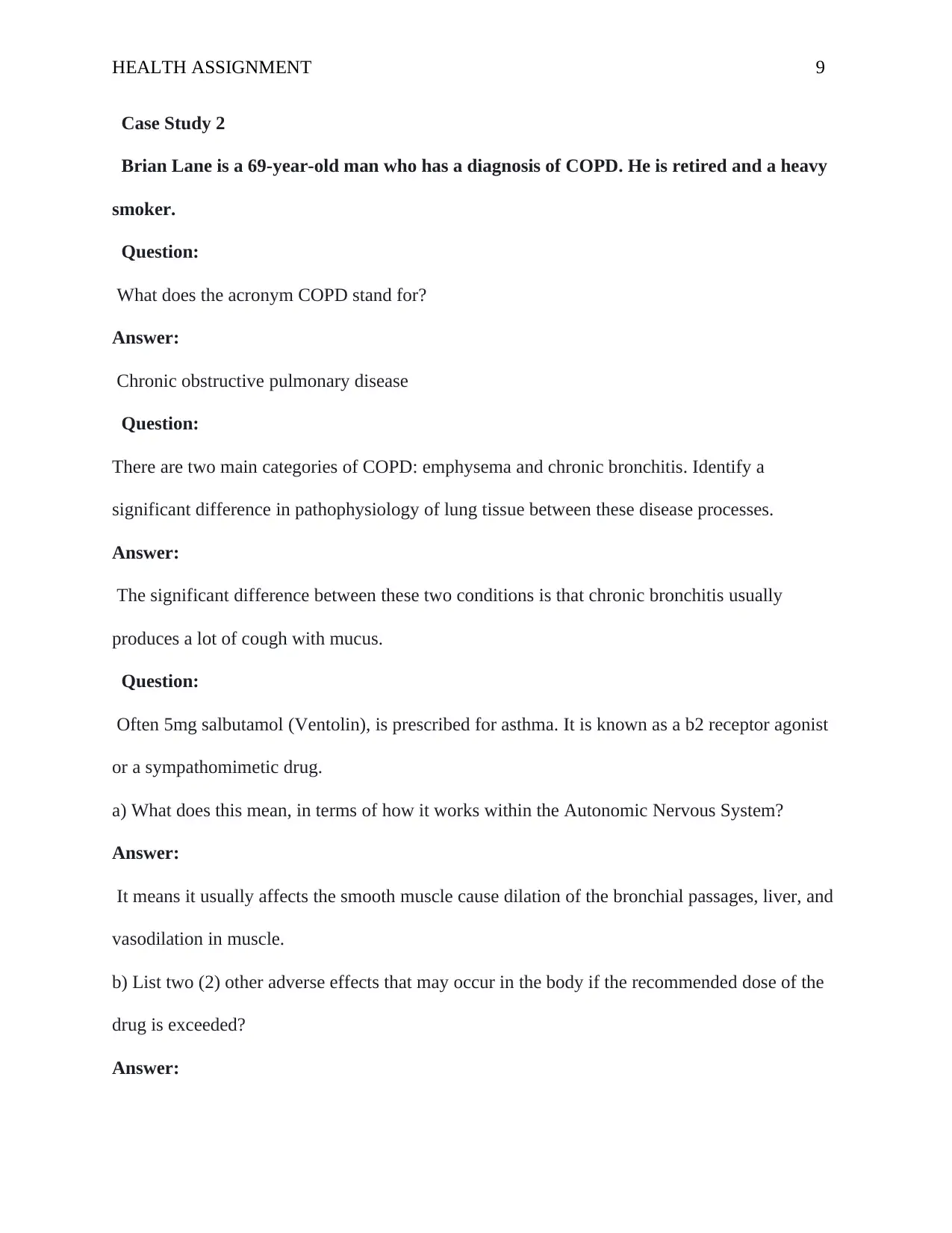
HEALTH ASSIGNMENT 9
Case Study 2
Brian Lane is a 69-year-old man who has a diagnosis of COPD. He is retired and a heavy
smoker.
Question:
What does the acronym COPD stand for?
Answer:
Chronic obstructive pulmonary disease
Question:
There are two main categories of COPD: emphysema and chronic bronchitis. Identify a
significant difference in pathophysiology of lung tissue between these disease processes.
Answer:
The significant difference between these two conditions is that chronic bronchitis usually
produces a lot of cough with mucus.
Question:
Often 5mg salbutamol (Ventolin), is prescribed for asthma. It is known as a b2 receptor agonist
or a sympathomimetic drug.
a) What does this mean, in terms of how it works within the Autonomic Nervous System?
Answer:
It means it usually affects the smooth muscle cause dilation of the bronchial passages, liver, and
vasodilation in muscle.
b) List two (2) other adverse effects that may occur in the body if the recommended dose of the
drug is exceeded?
Answer:
Case Study 2
Brian Lane is a 69-year-old man who has a diagnosis of COPD. He is retired and a heavy
smoker.
Question:
What does the acronym COPD stand for?
Answer:
Chronic obstructive pulmonary disease
Question:
There are two main categories of COPD: emphysema and chronic bronchitis. Identify a
significant difference in pathophysiology of lung tissue between these disease processes.
Answer:
The significant difference between these two conditions is that chronic bronchitis usually
produces a lot of cough with mucus.
Question:
Often 5mg salbutamol (Ventolin), is prescribed for asthma. It is known as a b2 receptor agonist
or a sympathomimetic drug.
a) What does this mean, in terms of how it works within the Autonomic Nervous System?
Answer:
It means it usually affects the smooth muscle cause dilation of the bronchial passages, liver, and
vasodilation in muscle.
b) List two (2) other adverse effects that may occur in the body if the recommended dose of the
drug is exceeded?
Answer:
⊘ This is a preview!⊘
Do you want full access?
Subscribe today to unlock all pages.

Trusted by 1+ million students worldwide
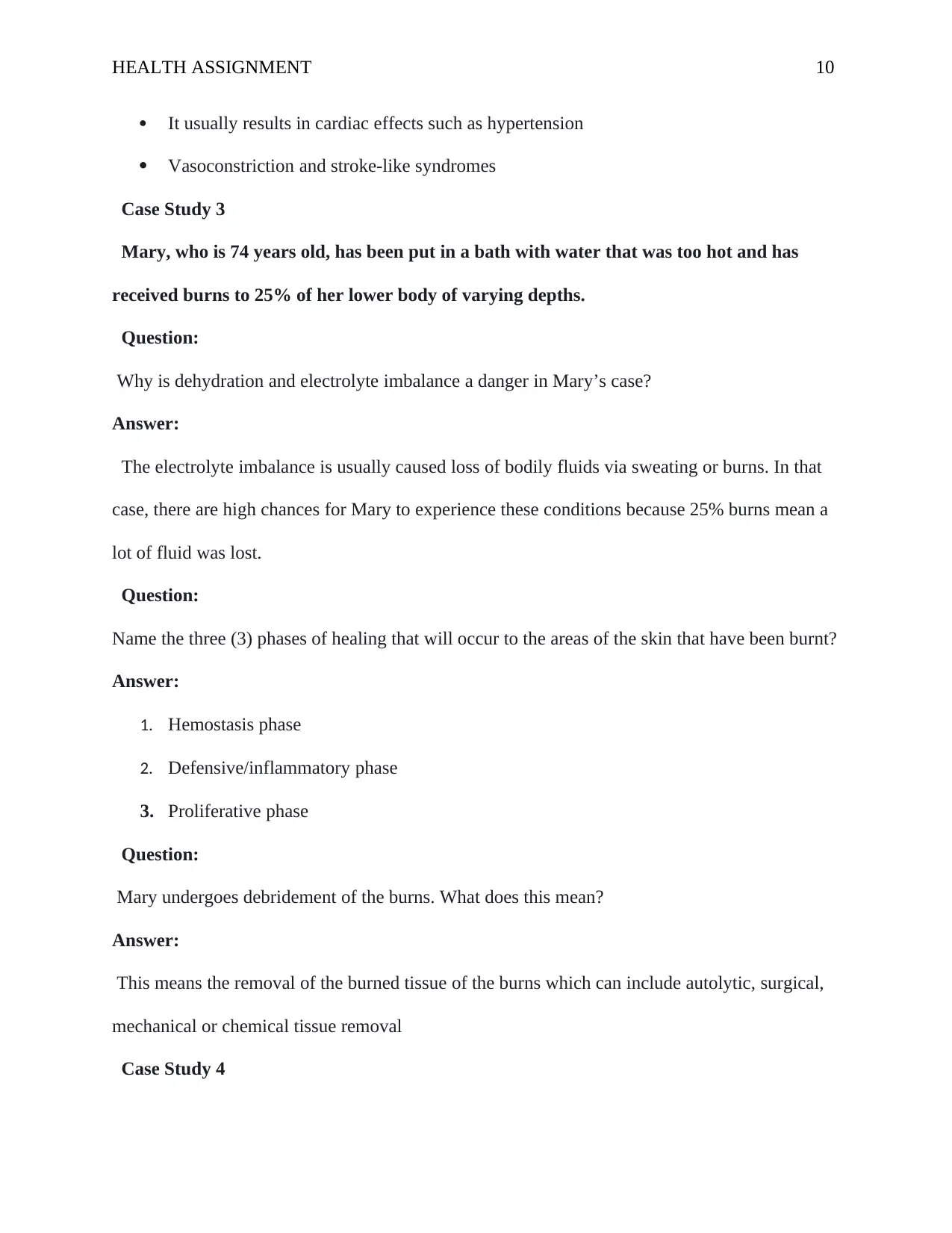
HEALTH ASSIGNMENT 10
It usually results in cardiac effects such as hypertension
Vasoconstriction and stroke-like syndromes
Case Study 3
Mary, who is 74 years old, has been put in a bath with water that was too hot and has
received burns to 25% of her lower body of varying depths.
Question:
Why is dehydration and electrolyte imbalance a danger in Mary’s case?
Answer:
The electrolyte imbalance is usually caused loss of bodily fluids via sweating or burns. In that
case, there are high chances for Mary to experience these conditions because 25% burns mean a
lot of fluid was lost.
Question:
Name the three (3) phases of healing that will occur to the areas of the skin that have been burnt?
Answer:
1. Hemostasis phase
2. Defensive/inflammatory phase
3. Proliferative phase
Question:
Mary undergoes debridement of the burns. What does this mean?
Answer:
This means the removal of the burned tissue of the burns which can include autolytic, surgical,
mechanical or chemical tissue removal
Case Study 4
It usually results in cardiac effects such as hypertension
Vasoconstriction and stroke-like syndromes
Case Study 3
Mary, who is 74 years old, has been put in a bath with water that was too hot and has
received burns to 25% of her lower body of varying depths.
Question:
Why is dehydration and electrolyte imbalance a danger in Mary’s case?
Answer:
The electrolyte imbalance is usually caused loss of bodily fluids via sweating or burns. In that
case, there are high chances for Mary to experience these conditions because 25% burns mean a
lot of fluid was lost.
Question:
Name the three (3) phases of healing that will occur to the areas of the skin that have been burnt?
Answer:
1. Hemostasis phase
2. Defensive/inflammatory phase
3. Proliferative phase
Question:
Mary undergoes debridement of the burns. What does this mean?
Answer:
This means the removal of the burned tissue of the burns which can include autolytic, surgical,
mechanical or chemical tissue removal
Case Study 4
Paraphrase This Document
Need a fresh take? Get an instant paraphrase of this document with our AI Paraphraser
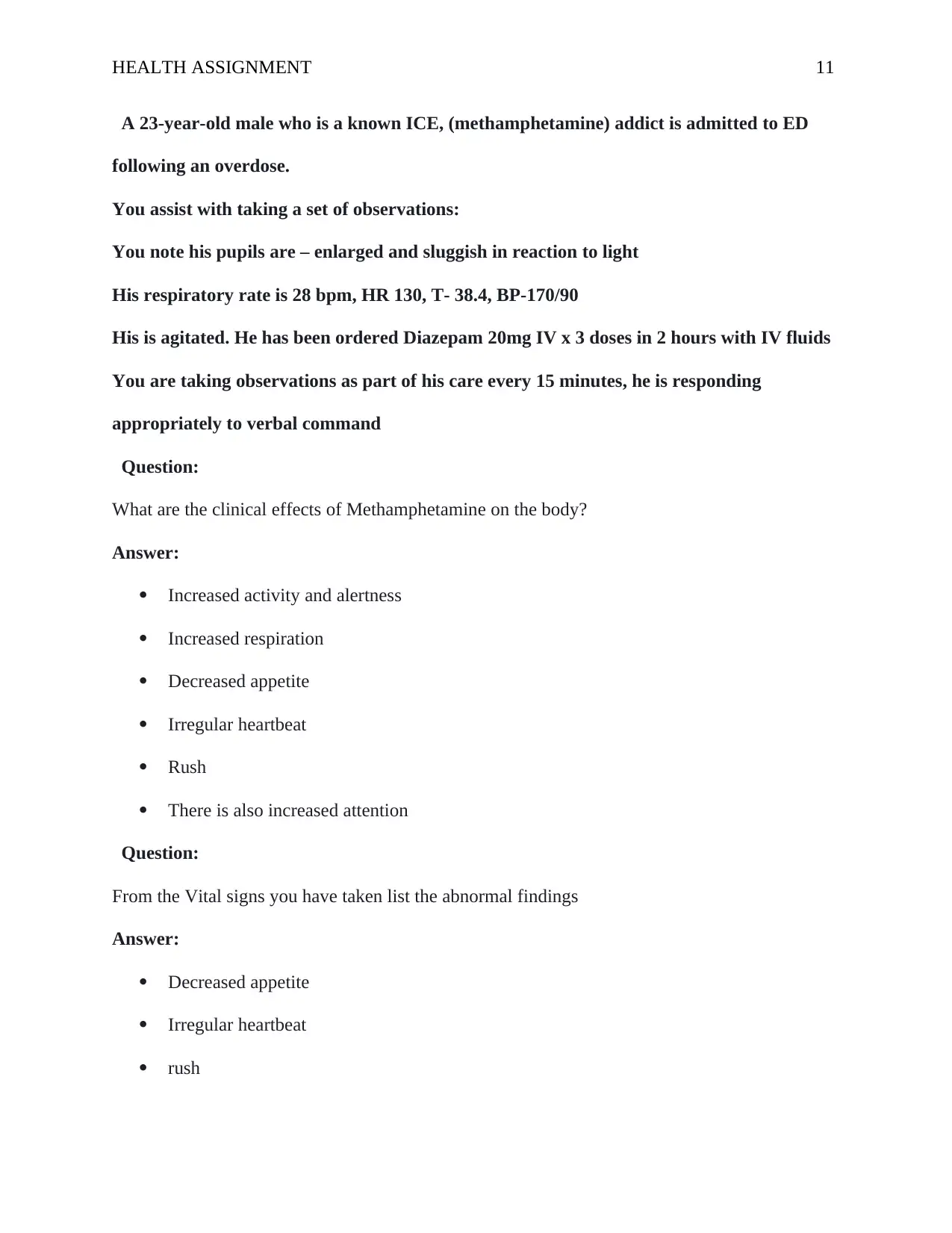
HEALTH ASSIGNMENT 11
A 23-year-old male who is a known ICE, (methamphetamine) addict is admitted to ED
following an overdose.
You assist with taking a set of observations:
You note his pupils are – enlarged and sluggish in reaction to light
His respiratory rate is 28 bpm, HR 130, T- 38.4, BP-170/90
His is agitated. He has been ordered Diazepam 20mg IV x 3 doses in 2 hours with IV fluids
You are taking observations as part of his care every 15 minutes, he is responding
appropriately to verbal command
Question:
What are the clinical effects of Methamphetamine on the body?
Answer:
Increased activity and alertness
Increased respiration
Decreased appetite
Irregular heartbeat
Rush
There is also increased attention
Question:
From the Vital signs you have taken list the abnormal findings
Answer:
Decreased appetite
Irregular heartbeat
rush
A 23-year-old male who is a known ICE, (methamphetamine) addict is admitted to ED
following an overdose.
You assist with taking a set of observations:
You note his pupils are – enlarged and sluggish in reaction to light
His respiratory rate is 28 bpm, HR 130, T- 38.4, BP-170/90
His is agitated. He has been ordered Diazepam 20mg IV x 3 doses in 2 hours with IV fluids
You are taking observations as part of his care every 15 minutes, he is responding
appropriately to verbal command
Question:
What are the clinical effects of Methamphetamine on the body?
Answer:
Increased activity and alertness
Increased respiration
Decreased appetite
Irregular heartbeat
Rush
There is also increased attention
Question:
From the Vital signs you have taken list the abnormal findings
Answer:
Decreased appetite
Irregular heartbeat
rush
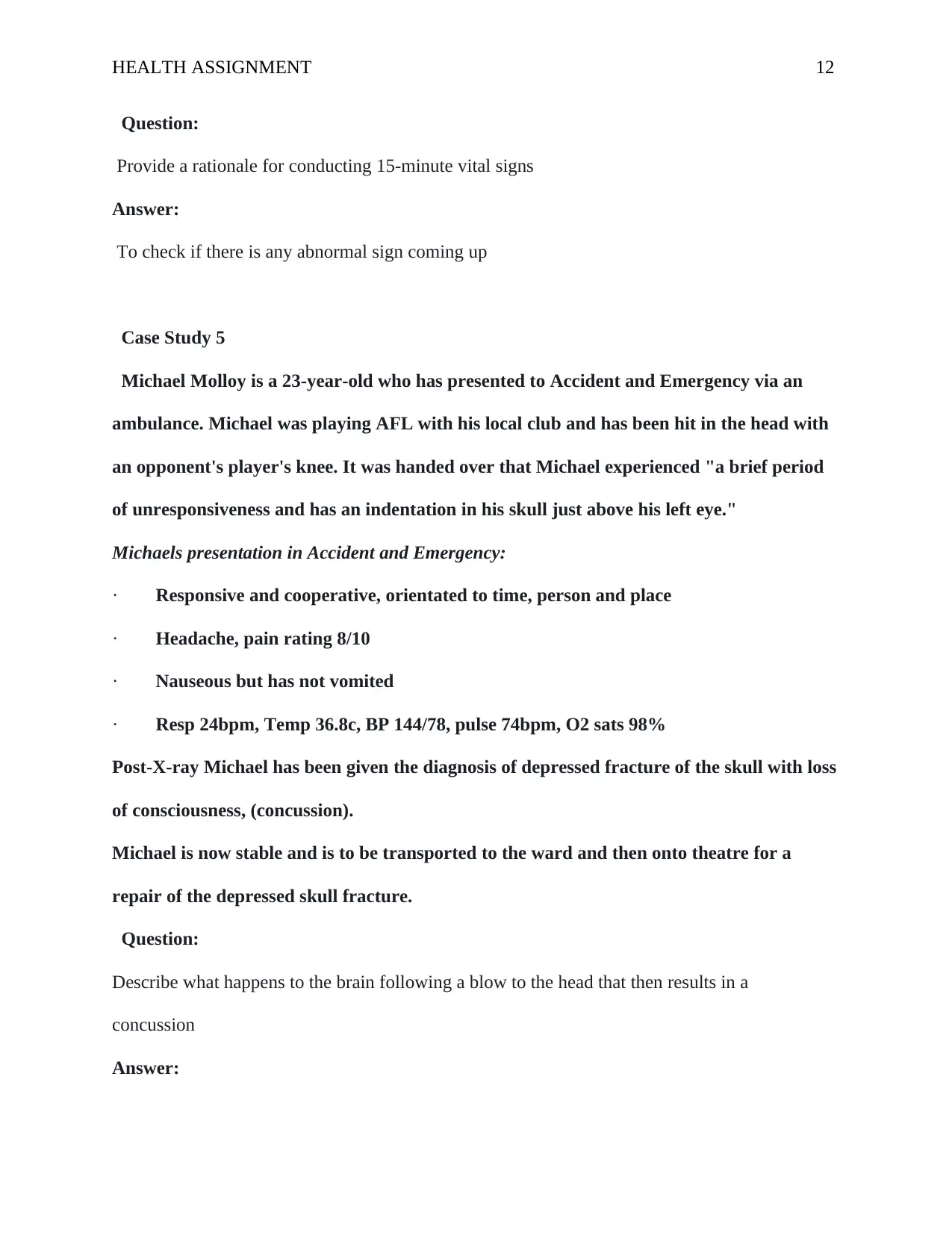
HEALTH ASSIGNMENT 12
Question:
Provide a rationale for conducting 15-minute vital signs
Answer:
To check if there is any abnormal sign coming up
Case Study 5
Michael Molloy is a 23-year-old who has presented to Accident and Emergency via an
ambulance. Michael was playing AFL with his local club and has been hit in the head with
an opponent's player's knee. It was handed over that Michael experienced "a brief period
of unresponsiveness and has an indentation in his skull just above his left eye."
Michaels presentation in Accident and Emergency:
· Responsive and cooperative, orientated to time, person and place
· Headache, pain rating 8/10
· Nauseous but has not vomited
· Resp 24bpm, Temp 36.8c, BP 144/78, pulse 74bpm, O2 sats 98%
Post-X-ray Michael has been given the diagnosis of depressed fracture of the skull with loss
of consciousness, (concussion).
Michael is now stable and is to be transported to the ward and then onto theatre for a
repair of the depressed skull fracture.
Question:
Describe what happens to the brain following a blow to the head that then results in a
concussion
Answer:
Question:
Provide a rationale for conducting 15-minute vital signs
Answer:
To check if there is any abnormal sign coming up
Case Study 5
Michael Molloy is a 23-year-old who has presented to Accident and Emergency via an
ambulance. Michael was playing AFL with his local club and has been hit in the head with
an opponent's player's knee. It was handed over that Michael experienced "a brief period
of unresponsiveness and has an indentation in his skull just above his left eye."
Michaels presentation in Accident and Emergency:
· Responsive and cooperative, orientated to time, person and place
· Headache, pain rating 8/10
· Nauseous but has not vomited
· Resp 24bpm, Temp 36.8c, BP 144/78, pulse 74bpm, O2 sats 98%
Post-X-ray Michael has been given the diagnosis of depressed fracture of the skull with loss
of consciousness, (concussion).
Michael is now stable and is to be transported to the ward and then onto theatre for a
repair of the depressed skull fracture.
Question:
Describe what happens to the brain following a blow to the head that then results in a
concussion
Answer:
⊘ This is a preview!⊘
Do you want full access?
Subscribe today to unlock all pages.

Trusted by 1+ million students worldwide
1 out of 22
Related Documents
Your All-in-One AI-Powered Toolkit for Academic Success.
+13062052269
info@desklib.com
Available 24*7 on WhatsApp / Email
![[object Object]](/_next/static/media/star-bottom.7253800d.svg)
Unlock your academic potential
Copyright © 2020–2025 A2Z Services. All Rights Reserved. Developed and managed by ZUCOL.



